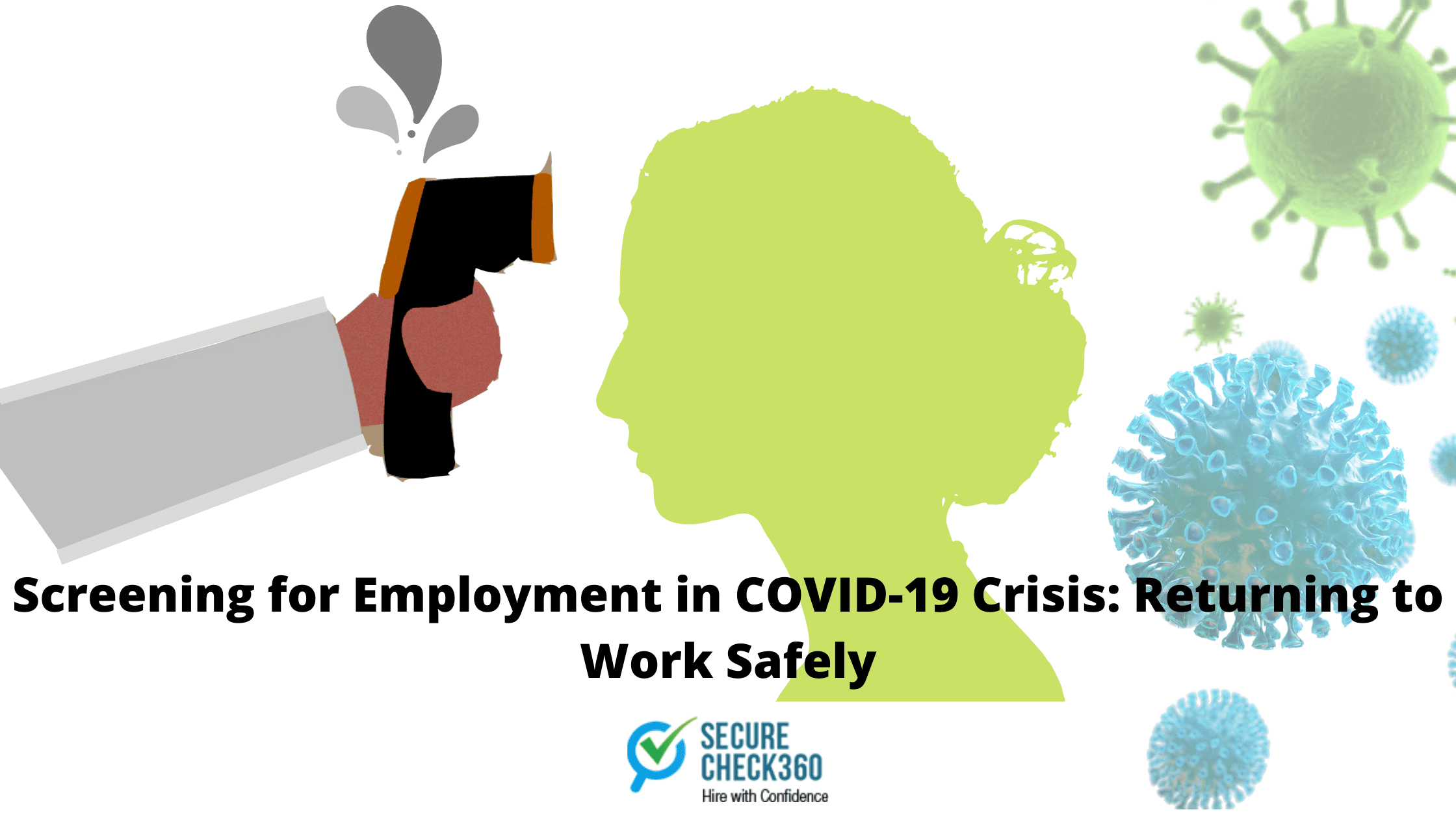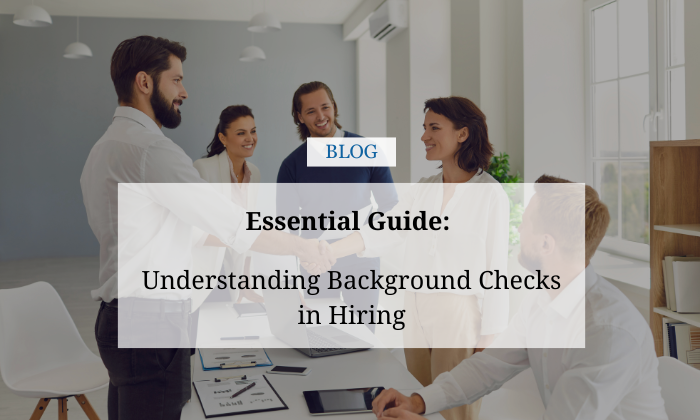States across the nation are re-opening. Now businesses are challenged to help ensure that the workplaces that their valued employees and customers will be populating are safe.
Planning
A myriad of issues must be addressed to ensure compliance with applicable regulations:
- Learn what employees can be asked regarding symptoms
- Know how to handle confidential medical information gained from screens
- Determine which screens may be used, their appropriateness for your needs, pros, and cons, and cost
First, management must create a policy that defines the organization’s goals to help ensure that the workplace, employees, and customers are kept virus-free during this and future pandemics (for more detail, please refer to the CDC’s guidelines):
- Create a formal plan to manage and respond to the crisis
- Incorporate basic contagion prevention measures
- Draft procedures to immediately handle the identification and isolation of sick individuals
- Follow existing Occupational Safety and Health Administration (OSHA) standards that require each employer furnish to each of its employees a workplace that is free from recognized hazards that are causing or likely to cause death or serious physical harm
- Please carefully review the document created by the U.S. Equal Employment Opportunity Commission (EEOC) that consolidates relevant coronavirus and COVID-19 information and answers questions from the public about the EEO laws and COVID-19
- Securecheck360 offers an article titled “What Employers Should Consider as They Draft a Return to Work Policy?” exploring the spectrum of Federal, State, and Local guidelines to consider.
- Have a screening program in place will mitigate several different risks, including:
- Risk of return to work mass absenteeism due to pandemic
- Risk of employee lawsuit for not providing a safe workplace
- Risk of reputational loss due to an outbreak
- Plan for temporary and permanent succession in case key employees may be side-lined during a crisis.
Prospective, furloughed, or current employee?
When considering bringing employees back on-board, distinguish between current employees and furloughed employees. They may be treated differently.
An employer may not ask a prospective employee about symptoms nor take their temperature until a conditional offer of employment is offered or a furloughed employee is directed to return to work. If a candidate for a furloughed employee is exhibiting symptoms or has an elevated temperature, the employer may either delay the start date or rescind the conditional offer of employment or return to a work order.
For a current employee, employers may ask if they are experiencing symptoms of COVID-19. This can be done when employees enter the office or begin their shift. They can be asked to complete a simple questionnaire. If the employer keeps these COVID-19 related inquiries, they must be treated as confidential medical information.
It is permissible for employers to take the temperatures of employees before entering the workplace and, ideally, at regular intervals throughout the day. Logs of temperatures must also be treated as confidential medical information.
Policies regarding questionnaires and taking of temperatures must be applied uniformly to all employees, at every level of the organization. Organizations that create a written policy stating that the employer has initiated these practices to help prevent the spread of an infectious disease in the workplace can prevent claims that the practices are not being uniformly applied or are in any way discriminatory, it may also help reassume staff that your company is doing everything possible to ensure their employees’ health, wellbeing, and welfare.
Screening Mechanisms
Questionnaire
Early in the pandemic, companies deployed respiratory illness symptom questionnaires as a mechanism to screen people for evidence of COVID-19. As employees are returning to their place of employment, symptom questionnaires remain a key mechanism to assure a safe return to work. If an employee states he/she had a fever or exhibited other typical COVID-19 symptoms, that information should be used to prevent the employee from returning to duty until after the symptoms resolve for a period of days. As with any other medical information, that questionnaire must be held as confidential information.
Organizations must be able to confidently separate the ill from the at-risk from the healthy. These questionnaires are easy to distribute and may be defensible. But while they may help, individuals may not have completed them honestly. An employee may have had a fever but not be infected by COVID-19. Obviously, additional and more reliable testing is required.
Testing for COVID-19
Viral and antibody tests
The type of test used by an organization may be decided by the company and how risk-averse they want to be.
According to the CDC, there are two kinds of tests that are available for COVID-19: viral tests (also referred to as antigen tests) and antibody tests.
- A viral test tells you if you have a current infection
- An antibody test tells you if you had a previous infection
An antibody test may not be able to show if you have a current infection, because it can take about one week after infection to make a detectable level of antibodies.
From a return to work testing perspective, there are three use cases for COVID-19 testing delineated below.
Viral (Antigen) Testing Alone
Testing for the specific evidence of COVID-19 is a feasible way to both screen employees in mass returning to work as well as testing people who become symptomatic at work. This type of testing only reveals if the person has or does not have the virus at the same time as the test. It also does not predict if a person is immune or stratify them for future risk.
One use case for viral testing as a standalone screening mechanism is as follows:
- All employees returning to work are screened using a symptom questionnaire
- Those employees who are asymptomatic are eligible to return to work
- People who are asymptomatic are told to inform their employer after they are symptom-free for 10 days
- If an employee develops symptoms at work, that person is immediately removed from the workplace and sent home.
- A viral antigen test for COVID-19 is conducted
- If that test is negative, the person can return to work after being symptom free for 7 days
- If that test is positive, a repeat antigen test can be conducted to assure he/she is no longer infective after being symptom free for 7 days
- Further, if the test is positive for the evidence of COVID-19, exposed co-workers can be identified, removed from the workplace, and tested
Antibody Testing Alone
Antibody testing is a test that looks for an immune response triggered after being exposed to a virus-like COVID-19. These tests have received bad press since some of the original FDA-cleared tests were not specific for COVID-19, and these tests were cross-reactive with other known coronaviruses that have been infecting people for years. The antibody tests that have remained FDA approved/cleared are specific to COVID-19; therefore, these tests are excellent markers for COVID-19 exposure.
Antibody testing is conducted on blood samples. If a sample is positive for antibodies, it shows the person was exposed to and had an immune response to COVID-19. Antibody tests that are solely positive for the type of antibodies that appear at the end of an infection (Ig G) may convey the person is COVID-19 immune. Ig G specific to certain makers in Hepatitis viruses is evidence of immunity; however, COVID-19 is a respiratory virus. Historically, influenza viruses tend to change (mutate) often leading to new outbreaks. Therefore, a person may be immune to COVID-19 but may be susceptible to COVID-21. People with mixed antibodies detected, still may be shedding virus thus, they are still considered infective.
A use case for antibody testing as a standalone screening program is as follows:
- All employees returning to work are screened using a symptom questionnaire
- Those employees who are asymptomatic are eligible to be tested
- People who are asymptomatic can be tested for antibodies 14 days after resolution of symptoms
- Antibody test results (conducted on employees who are symptom-free)
- If the test is positive for Ig G only, the person can return to duty
- If the test reveals a mixed antibody response, the person remains out of duty for an additional 14 days
- A repeat antibody test is done to confirm only Ig G is present
- If the test is negative, the person can return to duty
- However, if respiratory symptoms arise, the person should be removed from duty until symptom-free for 7 days
- Antibody testing is conducted prior to returning to work
Comprehensive COVID-19 Testing Program
Leveraging the strengths of antibody and viral antigen testing provides employers the most robust testing solution for COVID-19. Antibody tests look for exposure, and antigen test looks for infectivity. Looking at staging these two tests affords a company a program that provides objective proof of immunity status and infectivity.
The use case for a blended comprehensive program looks something like this:
- All employees returning to work are screened using a symptom questionnaire
- Those employees who are asymptomatic are eligible to be tested
- People who are asymptomatic can be tested for 14 days after resolution of symptoms
- The initial test is an antibody test (conducted on employees who are symptom-free)
- If the test is positive, an immediate viral antigen test is conducted
- If the test is negative, the person can return to workplace duties
- For those who are antibody positive
- If the viral antigen test is negative this person can return to duty
- This person is likely immune to COVID-19
- If the viral antigen test is positive, the person can return to duty
- This person is likely immune to COVID-19
- If the viral antigen test is positive, the person should remain out of work for an additional 7 days
- At that time, another antigen test can be ordered to confirm the person is no longer infective
Any of the above types of testing is very objective and generally defensible. The type of program your organization may want is blessed with your company culture and risk mitigation strategy. With any screening program, the symptom questionnaire is the key. Having a mechanism to receive and review the questionnaire in a confidential manner is also important.
Final Considerations
Many individuals will want to continue practical social distancing, which will impact asking employees to stand in line to get tested. Many will not participate in large gatherings. Keep these concerns in mind when planning the distribution of questionnaires and testing. Management personnel should be employed to administer tests since the information they will be collecting must be maintained confidentially. Each must be properly trained.
Note that specific fields including healthcare may require more stringent testing and qualification.
For more information on screening, please visit: www.securecheck360.com
Or mail us at [email protected]







